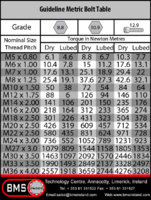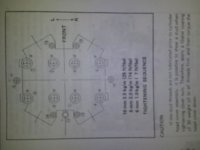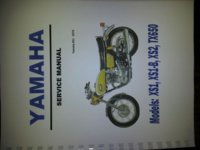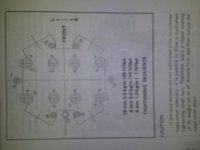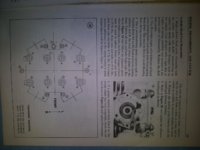I had to change the cam chain guide and I am ready to reassemble. What do I use on the bolts? Copper paste, loc tight, nothing? The top-bolts have to be thightend as specified but is that dry torque? And what about the bolts thats inside the engineand mostly covered in oil. Any need for copper paste there?
-
Enjoy XS650.com? Consider making a donation to help support the site.
XS650.com receives a small share of sales from some links on this page, but direct donations have a much greater impact on keeping this site going.
You are using an out of date browser. It may not display this or other websites correctly.
You should upgrade or use an alternative browser.
You should upgrade or use an alternative browser.
Original factory specs are for dry-torque. If threads and/or bold/nut bases are lubricated, must under-torque to maintain proper bolt/stud tension. By how much I don't know...
The factory service manual specifies lubricating the top end fasteners with oil before torquing to spec, and we generally get best results by increasing torque on the large fasteners to 28 to 30 foot pounds. There's no need to guess about this stuff or take questionable advice, Fossi. Download the factory book from www.biker.net .
I have found that reading the repair manual answers a lot of questions like this. Reading several manuals is even better.
Leo
Leo
Uncle Bryan
XS650 Addict
Is there a supplement for this?...


No supplement from Yamaha. The increased torque value for the 8 large acorn nuts comes from here, also the tip on replacing the rubber washers (a "must do" in my opinion) .....
http://www.650motorcycles.com/CopperWashers.html
http://www.650motorcycles.com/CopperWashers.html
Uncle Bryan
XS650 Addict
Thanks a million 5twins!
This is a perfect example of how us newbies can get lost. The factory manual doesn't even call for washers, let alone lube on the threads.
Thanks again.
Bryan
This is a perfect example of how us newbies can get lost. The factory manual doesn't even call for washers, let alone lube on the threads.
Thanks again.
Bryan
Speedthriller
XS650 Enthusiast
Yep, there it is, service manual page 18. To avoid stripping the stud threads, lube with motor oil.
Maybe that's why the head stud torque seems low?
When Japan cut over to the UBS system, we started getting service bulletins insisting on dry assembly and torque. That's where my head was at.
Thanks grizld1, my bad, sorry folks...
Maybe that's why the head stud torque seems low?
When Japan cut over to the UBS system, we started getting service bulletins insisting on dry assembly and torque. That's where my head was at.
Thanks grizld1, my bad, sorry folks...
Attachments
Speedthriller
XS650 Enthusiast
These studs are 10mm (M10). 3,5 kg-m (35Nm), that is about the same (38Nm) as what is in my torque table, TwoManyXS1Bs.
Last edited:
Purplezinger
XS650 Addict
I use "Never-Seez" anti seize compound. Replace the rubber coated washers with brass washers. Increase the torque as 5Twins recommends. Never-Seez can be purchased at industrial supply houses, Graingers, Bearings Inc, etc. I think John Deere sells it repackaged. I personally would never trust a torque reading on dry threads.
Uncle Bryan
XS650 Addict
Is it OK to use the brass washers on all 8 studs?
In my opinion it isn't OK to use brass at all for a sealing washer; use copper. Only the 4 outer studs go through oil bearing passages, and those are the only ones that require sealing washers.
^Where did you get that manual? I have the one Uncle B. put up and there's no mention of lubing the threads. In the back it says values are for dry threads unless otherwise called out.
This has been a mindbender for me as well, after years on indoctrination, this shows up...
Attached is the cover and pg18 of my 70-73 manual.
Also attached is the cover and pg13 of my 70-73 Clymer manual. Paragraph 2 calls for lubing the bolts too...
Attachments
As some of you may already know, during the 70s I worked primarily on H*ndas, including Harley, Triumph, Bultaco, Huskvarna and CZ. We received many service and tech bulletins from each, including industry news, sales propaganda, and an endless stream of supplier marketing malarky (especially lubricants).
Probably got dain-brammage from all that...
Anyway, please indulge as I try to regurgitate bolt/nut/stud history, as experienced from this side of the fence. H*nda was inundated with complaints of head and cyl base oil weepage, costing them lots in warranty claims and customer trust. The solutions (experiments) came from different directions, gasket mods, dowelpin-oring mods, head stud mods. The solution was to design complementary gaskets, cylinders and studs, so that the studs would apply specific tensions when cold and hot, the cylinders would expand within a specific range cold/hot, and the gaskets were to be compliant enough to absorb the difference, and had their compliance range defined to work within this regime. Enter the fastener engineers. They claimed that bolt/stud tension values were too variant using normal torque procedures. Enter the Unified Bearing Stress (UBS) system. Now we have bolts and nuts with a built-in flange, kinda like carriage bolts. Close examination of the flange shows it to be slightly concave, causing the initial torque friction to occur at the outer edge, creating a more reliable prediction of torque value to bolt/stud body tension. This UBS system was adopted into Japanese industry, and the tech bulletins flooded overseas. To use this, all fasteners were to be kept dry.
Enter the foibles of the grapevine. Always heard various do this and don't do that from various directions. More dain-brammage. AND, the bike shops had to sell existing inventory, the parts guys weren't kept up-to-date on all this, so various mixes of gaskets went out the door. Eventually the oil weepage problem reduced, but never totally went away.
Always heard various do this and don't do that from various directions. More dain-brammage. AND, the bike shops had to sell existing inventory, the parts guys weren't kept up-to-date on all this, so various mixes of gaskets went out the door. Eventually the oil weepage problem reduced, but never totally went away.
I left the industry after that, don't know how it transpired. Also don't know if/when or not it was utilized on other Japanese makes. I look now at XS650 headbolts/castle nuts in a new light now. If there is NO UBS flange, follow the manual, do it the old way. I like the idea of anti-sieze, and it looks like, now with the experience of adventurous XS'rs, that option is viable and preferred.
Hope you enjoyed that wallowing in retro-land. Regurgitate mode off...
Probably got dain-brammage from all that...
Anyway, please indulge as I try to regurgitate bolt/nut/stud history, as experienced from this side of the fence. H*nda was inundated with complaints of head and cyl base oil weepage, costing them lots in warranty claims and customer trust. The solutions (experiments) came from different directions, gasket mods, dowelpin-oring mods, head stud mods. The solution was to design complementary gaskets, cylinders and studs, so that the studs would apply specific tensions when cold and hot, the cylinders would expand within a specific range cold/hot, and the gaskets were to be compliant enough to absorb the difference, and had their compliance range defined to work within this regime. Enter the fastener engineers. They claimed that bolt/stud tension values were too variant using normal torque procedures. Enter the Unified Bearing Stress (UBS) system. Now we have bolts and nuts with a built-in flange, kinda like carriage bolts. Close examination of the flange shows it to be slightly concave, causing the initial torque friction to occur at the outer edge, creating a more reliable prediction of torque value to bolt/stud body tension. This UBS system was adopted into Japanese industry, and the tech bulletins flooded overseas. To use this, all fasteners were to be kept dry.
Enter the foibles of the grapevine.
 Always heard various do this and don't do that from various directions. More dain-brammage. AND, the bike shops had to sell existing inventory, the parts guys weren't kept up-to-date on all this, so various mixes of gaskets went out the door. Eventually the oil weepage problem reduced, but never totally went away.
Always heard various do this and don't do that from various directions. More dain-brammage. AND, the bike shops had to sell existing inventory, the parts guys weren't kept up-to-date on all this, so various mixes of gaskets went out the door. Eventually the oil weepage problem reduced, but never totally went away.I left the industry after that, don't know how it transpired. Also don't know if/when or not it was utilized on other Japanese makes. I look now at XS650 headbolts/castle nuts in a new light now. If there is NO UBS flange, follow the manual, do it the old way. I like the idea of anti-sieze, and it looks like, now with the experience of adventurous XS'rs, that option is viable and preferred.
Hope you enjoyed that wallowing in retro-land. Regurgitate mode off...
I've used anti-seize on the head nuts and bolts darn near forever, and not only on this bike but every other one I've ever owned. I've never reduced the torque values because of that and have never experienced any problems or stripped fasteners. But I probably should add that I have an assortment of good quality torque wrenches and know how to use them. A torque wrench is most accurate in the middle portion of it's range. In other words, it's not a good idea to apply 10 ft/lbs of torque to a bolt using a wrench whose scale starts at 10 ft/lbs.
Uncle Bryan
XS650 Addict
This has been a very interesting discussion for me. Like TwoMany's, I too worked in a Honda shop in the mid 70's and I understand what he is saying about all the service bulletins. Although my main education was on the automotive side, and I returned to that after my bike-shop time, I was always taught (on both sides) that torque values are always dry. But after this conversation, and some research, I'm going with the wet torque. I can also appreciate the notion of how much torsional tension there could be on those long studs, thus, further rationalizing the use of some lube on the friction inducing fasteners.
Good points here by all, and Fossi, sorry if I (we) hijacked your thread, but I hope you found your answer?
Bryan
Good points here by all, and Fossi, sorry if I (we) hijacked your thread, but I hope you found your answer?
Bryan
Thanks again for good help. No problem Uncle Brian. I love a good discussion and this one was close to the subject as well. I still don't know if its okay to use copper washers all over or not. I have ordered a bunch of Suzuki washers and was planning to use eight of those. I dont want to reuse any of the old washers from the mid seventies
Fossi, it's OK to use copper washers on all of the top end studs, but they're only needed on the 4 outer studs. The original steel washers are fine on the 4 inner studs, and I know of no reason not to reuse them.
Guys, regarding torque and lube, there are two reasons to measure torque on fasteners. One is to prevent damage to threads and/or fasteners due to overtightening, and the other is to achieve even pressure when joining two sealing surfaces. When you're joining things that need to seal, you need to be more accurate than threads that stick will allow, because what you're very indirectly measuring is the pressure exerted between the items you're joining. Maybe I'm strange, but I've been wrenching on motorcycles since 1965 and I can't even remember torquing top end fasteners dry.
Guys, regarding torque and lube, there are two reasons to measure torque on fasteners. One is to prevent damage to threads and/or fasteners due to overtightening, and the other is to achieve even pressure when joining two sealing surfaces. When you're joining things that need to seal, you need to be more accurate than threads that stick will allow, because what you're very indirectly measuring is the pressure exerted between the items you're joining. Maybe I'm strange, but I've been wrenching on motorcycles since 1965 and I can't even remember torquing top end fasteners dry.

